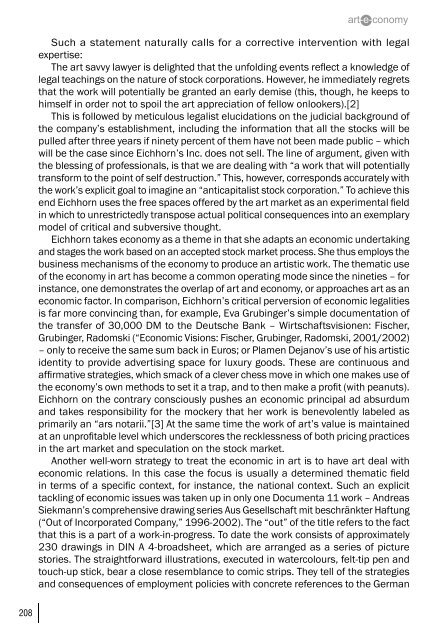art-e-conomy _ reader - marko stamenkovic
art-e-conomy _ reader - marko stamenkovic
art-e-conomy _ reader - marko stamenkovic
Create successful ePaper yourself
Turn your PDF publications into a flip-book with our unique Google optimized e-Paper software.
208<br />
Such a statement naturally calls for a corrective intervention with legal<br />
expertise:<br />
The <strong>art</strong> savvy lawyer is delighted that the unfolding events reflect a knowledge of<br />
legal teachings on the nature of stock corporations. However, he immediately regrets<br />
that the work will potentially be granted an early demise (this, though, he keeps to<br />
himself in order not to spoil the <strong>art</strong> appreciation of fellow onlookers).[2]<br />
This is followed by meticulous legalist elucidations on the judicial background of<br />
the company’s establishment, including the information that all the stocks will be<br />
pulled after three years if ninety percent of them have not been made public – which<br />
will be the case since Eichhorn’s Inc. does not sell. The line of argument, given with<br />
the blessing of professionals, is that we are dealing with “a work that will potentially<br />
transform to the point of self destruction.” This, however, corresponds accurately with<br />
the work’s explicit goal to imagine an “anticapitalist stock corporation.” To achieve this<br />
end Eichhorn uses the free spaces offered by the <strong>art</strong> market as an experimental field<br />
in which to unrestrictedly transpose actual political consequences into an exemplary<br />
model of critical and subversive thought.<br />
Eichhorn takes e<strong>conomy</strong> as a theme in that she adapts an economic undertaking<br />
and stages the work based on an accepted stock market process. She thus employs the<br />
business mechanisms of the e<strong>conomy</strong> to produce an <strong>art</strong>istic work. The thematic use<br />
of the e<strong>conomy</strong> in <strong>art</strong> has become a common operating mode since the nineties – for<br />
instance, one demonstrates the overlap of <strong>art</strong> and e<strong>conomy</strong>, or approaches <strong>art</strong> as an<br />
economic factor. In comparison, Eichhorn’s critical perversion of economic legalities<br />
is far more convincing than, for example, Eva Grubinger’s simple documentation of<br />
the transfer of 30,000 DM to the Deutsche Bank – Wirtschaftsvisionen: Fischer,<br />
Grubinger, Radomski (“Economic Visions: Fischer, Grubinger, Radomski, 2001/2002)<br />
– only to receive the same sum back in Euros; or Plamen Dejanov’s use of his <strong>art</strong>istic<br />
identity to provide advertising space for luxury goods. These are continuous and<br />
affirmative strategies, which smack of a clever chess move in which one makes use of<br />
the e<strong>conomy</strong>’s own methods to set it a trap, and to then make a profit (with peanuts).<br />
Eichhorn on the contrary consciously pushes an economic principal ad absurdum<br />
and takes responsibility for the mockery that her work is benevolently labeled as<br />
primarily an “ars notarii.”[3] At the same time the work of <strong>art</strong>’s value is maintained<br />
at an unprofitable level which underscores the recklessness of both pricing practices<br />
in the <strong>art</strong> market and speculation on the stock market.<br />
Another well-worn strategy to treat the economic in <strong>art</strong> is to have <strong>art</strong> deal with<br />
economic relations. In this case the focus is usually a determined thematic field<br />
in terms of a specific context, for instance, the national context. Such an explicit<br />
tackling of economic issues was taken up in only one Documenta 11 work – Andreas<br />
Siekmann’s comprehensive drawing series Aus Gesellschaft mit beschränkter Haftung<br />
(“Out of Incorporated Company,” 1996-2002). The “out” of the title refers to the fact<br />
that this is a p<strong>art</strong> of a work-in-progress. To date the work consists of approximately<br />
230 drawings in DIN A 4-broadsheet, which are arranged as a series of picture<br />
stories. The straightforward illustrations, executed in watercolours, felt-tip pen and<br />
touch-up stick, bear a close resemblance to comic strips. They tell of the strategies<br />
and consequences of employment policies with concrete references to the German


